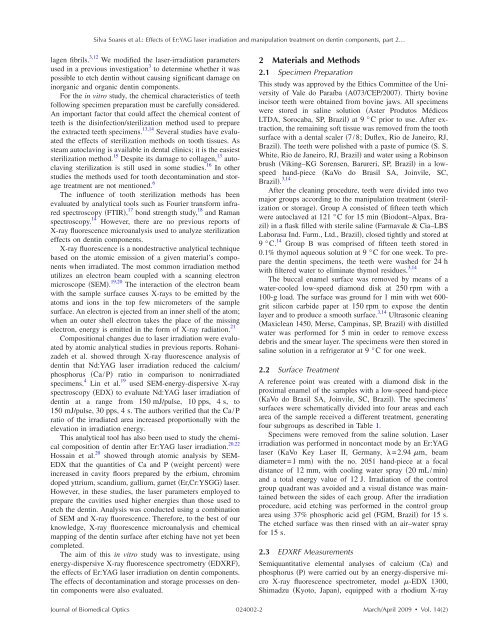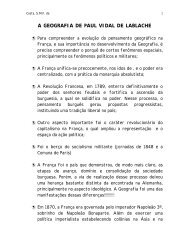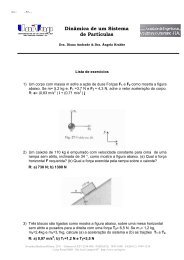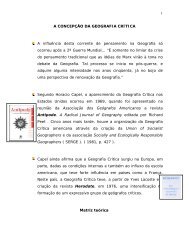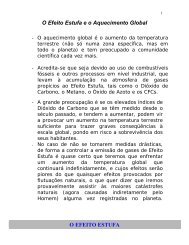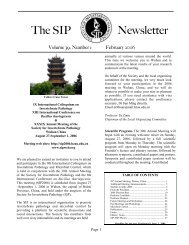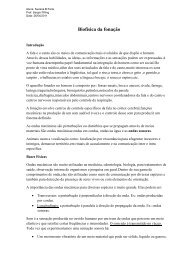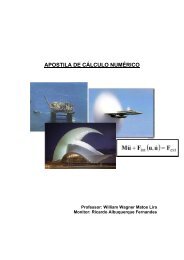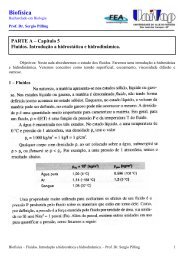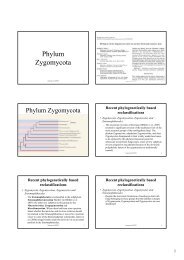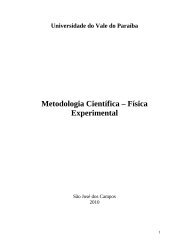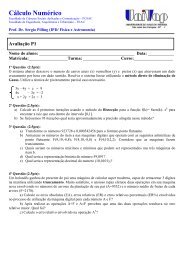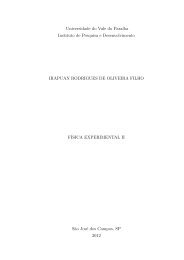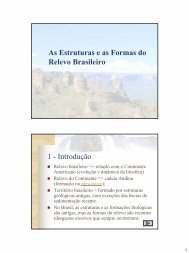Effects of Er:YAG laser irradiation and manipulation ... - Univap
Effects of Er:YAG laser irradiation and manipulation ... - Univap
Effects of Er:YAG laser irradiation and manipulation ... - Univap
Create successful ePaper yourself
Turn your PDF publications into a flip-book with our unique Google optimized e-Paper software.
Silva Soares et al.: <strong>Effects</strong> <strong>of</strong> <strong>Er</strong>:<strong>YAG</strong> <strong>laser</strong> <strong>irradiation</strong> <strong>and</strong> <strong>manipulation</strong> treatment on dentin components, part 2…<br />
lagen fibrils. 3,12 We modified the <strong>laser</strong>-<strong>irradiation</strong> parameters<br />
used in a previous investigation 3 to determine whether it was<br />
possible to etch dentin without causing significant damage on<br />
inorganic <strong>and</strong> organic dentin components.<br />
For the in vitro study, the chemical characteristics <strong>of</strong> teeth<br />
following specimen preparation must be carefully considered.<br />
An important factor that could affect the chemical content <strong>of</strong><br />
teeth is the disinfection/sterilization method used to prepare<br />
the extracted teeth specimens. 13,14 Several studies have evaluated<br />
the effects <strong>of</strong> sterilization methods on tooth tissues. As<br />
steam autoclaving is available in dental clinics; it is the easiest<br />
sterilization method. 15 Despite its damage to collagen, 13 autoclaving<br />
sterilization is still used in some studies. 16 In other<br />
studies the methods used for tooth decontamination <strong>and</strong> storage<br />
treatment are not mentioned. 6<br />
The influence <strong>of</strong> tooth sterilization methods has been<br />
evaluated by analytical tools such as Fourier transform infrared<br />
spectroscopy FTIR, 17 bond strength study, 18 <strong>and</strong> Raman<br />
spectroscopy. 14 However, there are no previous reports <strong>of</strong><br />
X-ray fluorescence microanalysis used to analyze sterilization<br />
effects on dentin components.<br />
X-ray fluorescence is a nondestructive analytical technique<br />
based on the atomic emission <strong>of</strong> a given material’s components<br />
when irradiated. The most common <strong>irradiation</strong> method<br />
utilizes an electron beam coupled with a scanning electron<br />
microscope SEM. 19,20 The interaction <strong>of</strong> the electron beam<br />
with the sample surface causes X-rays to be emitted by the<br />
atoms <strong>and</strong> ions in the top few micrometers <strong>of</strong> the sample<br />
surface. An electron is ejected from an inner shell <strong>of</strong> the atom;<br />
when an outer shell electron takes the place <strong>of</strong> the missing<br />
electron, energy is emitted in the form <strong>of</strong> X-ray radiation. 21<br />
Compositional changes due to <strong>laser</strong> <strong>irradiation</strong> were evaluated<br />
by atomic analytical studies in previous reports. Rohanizadeh<br />
et al. showed through X-ray fluorescence analysis <strong>of</strong><br />
dentin that Nd:<strong>YAG</strong> <strong>laser</strong> <strong>irradiation</strong> reduced the calcium/<br />
phosphorus Ca/P ratio in comparison to nonirradiated<br />
specimens. 4 Lin et al. 19 used SEM-energy-dispersive X-ray<br />
spectroscopy EDX to evaluate Nd:<strong>YAG</strong> <strong>laser</strong> <strong>irradiation</strong> <strong>of</strong><br />
dentin at a range from 150 mJ/pulse, 10 pps, 4s, to<br />
150 mJ/pulse, 30 pps, 4s. The authors verified that the Ca/P<br />
ratio <strong>of</strong> the irradiated area increased proportionally with the<br />
elevation in <strong>irradiation</strong> energy.<br />
This analytical tool has also been used to study the chemical<br />
composition <strong>of</strong> dentin after <strong>Er</strong>:<strong>YAG</strong> <strong>laser</strong> <strong>irradiation</strong>. 20,22<br />
Hossain et al. 20 showed through atomic analysis by SEM-<br />
EDX that the quantities <strong>of</strong> Ca <strong>and</strong> P weight percent were<br />
increased in cavity floors prepared by the erbium, chromim<br />
doped yttrium, sc<strong>and</strong>ium, gallium, garnet <strong>Er</strong>,Cr:YSGG <strong>laser</strong>.<br />
However, in these studies, the <strong>laser</strong> parameters employed to<br />
prepare the cavities used higher energies than those used to<br />
etch the dentin. Analysis was conducted using a combination<br />
<strong>of</strong> SEM <strong>and</strong> X-ray fluorescence. Therefore, to the best <strong>of</strong> our<br />
knowledge, X-ray fluorescence microanalysis <strong>and</strong> chemical<br />
mapping <strong>of</strong> the dentin surface after etching have not yet been<br />
completed.<br />
The aim <strong>of</strong> this in vitro study was to investigate, using<br />
energy-dispersive X-ray fluorescence spectrometry EDXRF,<br />
the effects <strong>of</strong> <strong>Er</strong>:<strong>YAG</strong> <strong>laser</strong> <strong>irradiation</strong> on dentin components.<br />
The effects <strong>of</strong> decontamination <strong>and</strong> storage processes on dentin<br />
components were also evaluated.<br />
2 Materials <strong>and</strong> Methods<br />
2.1 Specimen Preparation<br />
This study was approved by the Ethics Committee <strong>of</strong> the University<br />
<strong>of</strong> Vale do Paraíba A073/CEP/2007. Thirty bovine<br />
incisor teeth were obtained from bovine jaws. All specimens<br />
were stored in saline solution Aster Produtos Médicos<br />
LTDA, Sorocaba, SP, Brazil at 9°Cprior to use. After extraction,<br />
the remaining s<strong>of</strong>t tissue was removed from the tooth<br />
surface with a dental scaler 7/8; Duflex, Rio de Janeiro, RJ,<br />
Brazil. The teeth were polished with a paste <strong>of</strong> pumice S. S.<br />
White, Rio de Janeiro, RJ, Brazil <strong>and</strong> water using a Robinson<br />
brush Viking–KG Sorensen, Barureri, SP, Brazil in a lowspeed<br />
h<strong>and</strong>-piece KaVo do Brasil SA, Joinvile, SC,<br />
Brazil. 3,14<br />
After the cleaning procedure, teeth were divided into two<br />
major groups according to the <strong>manipulation</strong> treatment sterilization<br />
or storage. Group A consisted <strong>of</strong> fifteen teeth which<br />
were autoclaved at 121 °C for 15 min Biodont–Alpax, Brazil<br />
in a flask filled with sterile saline Farmavale & Cia–LBS<br />
Laborasa Ind. Farm., Ltd., Brazil, closed tightly <strong>and</strong> stored at<br />
9°C. 14 Group B was comprised <strong>of</strong> fifteen teeth stored in<br />
0.1% thymol aqueous solution at 9°Cfor one week. To prepare<br />
the dentin specimens, the teeth were washed for 24 h<br />
with filtered water to eliminate thymol residues. 3,14<br />
The buccal enamel surface was removed by means <strong>of</strong> a<br />
water-cooled low-speed diamond disk at 250 rpm with a<br />
100-g load. The surface was ground for 1 min with wet 600-<br />
grit silicon carbide paper at 150 rpm to expose the dentin<br />
layer <strong>and</strong> to produce a smooth surface. 3,14 Ultrasonic cleaning<br />
Maxiclean 1450, Merse, Campinas, SP, Brazil with distilled<br />
water was performed for 5 min in order to remove excess<br />
debris <strong>and</strong> the smear layer. The specimens were then stored in<br />
saline solution in a refrigerator at 9°Cfor one week.<br />
2.2 Surface Treatment<br />
A reference point was created with a diamond disk in the<br />
proximal enamel <strong>of</strong> the samples with a low-speed h<strong>and</strong>-piece<br />
KaVo do Brasil SA, Joinvile, SC, Brazil. The specimens’<br />
surfaces were schematically divided into four areas <strong>and</strong> each<br />
area <strong>of</strong> the sample received a different treatment, generating<br />
four subgroups as described in Table 1.<br />
Specimens were removed from the saline solution. Laser<br />
<strong>irradiation</strong> was performed in noncontact mode by an <strong>Er</strong>:<strong>YAG</strong><br />
<strong>laser</strong> KaVo Key Laser II, Germany, =2.94 m, beam<br />
diameter=1 mm with the no. 2051 h<strong>and</strong>-piece at a focal<br />
distance <strong>of</strong> 12 mm, with cooling water spray 20 mL/min<br />
<strong>and</strong> a total energy value <strong>of</strong> 12 J. Irradiation <strong>of</strong> the control<br />
group quadrant was avoided <strong>and</strong> a visual distance was maintained<br />
between the sides <strong>of</strong> each group. After the <strong>irradiation</strong><br />
procedure, acid etching was performed in the control group<br />
area using 37% phosphoric acid gel FGM, Brazil for 15 s.<br />
The etched surface was then rinsed with an air–water spray<br />
for 15 s.<br />
2.3 EDXRF Measurements<br />
Semiquantitative elemental analyses <strong>of</strong> calcium Ca <strong>and</strong><br />
phosphorus P were carried out by an energy-dispersive micro<br />
X-ray fluorescence spectrometer, model -EDX 1300,<br />
Shimadzu Kyoto, Japan, equipped with a rhodium X-ray<br />
Journal <strong>of</strong> Biomedical Optics 024002-2<br />
March/April 2009 Vol. 142


